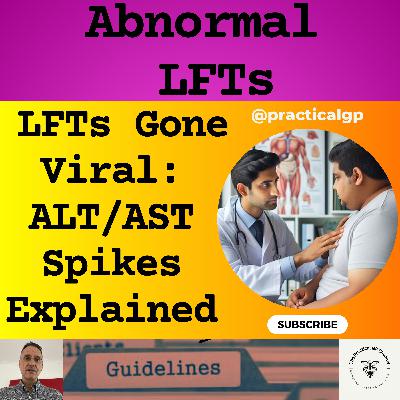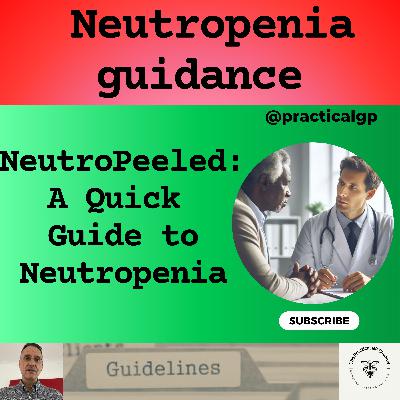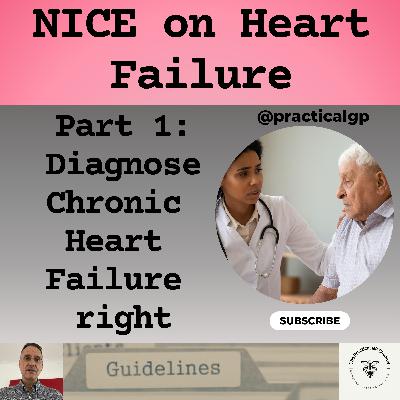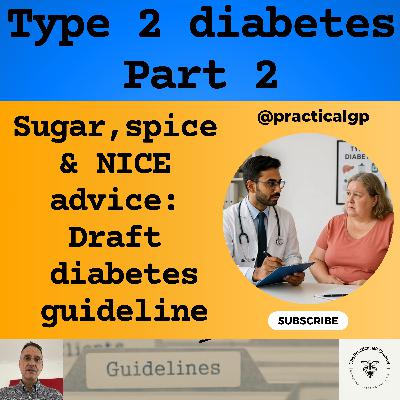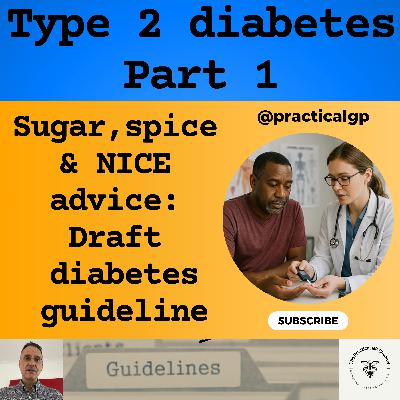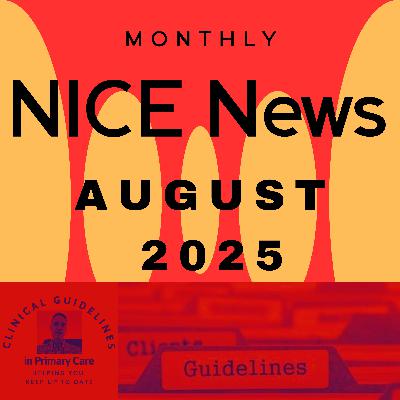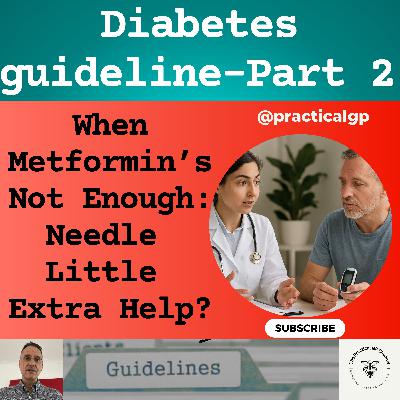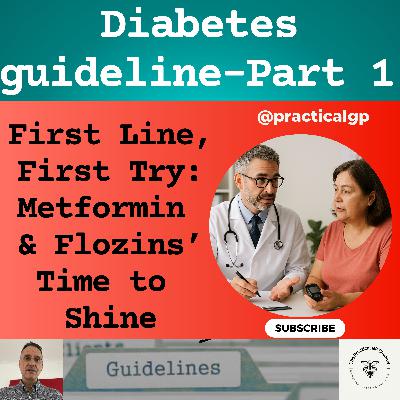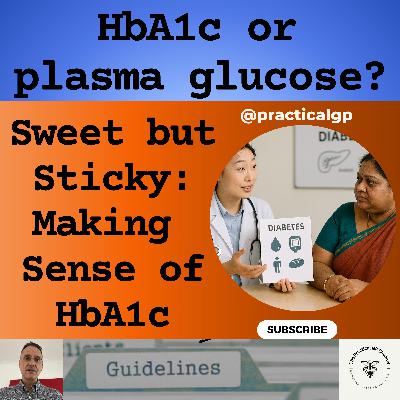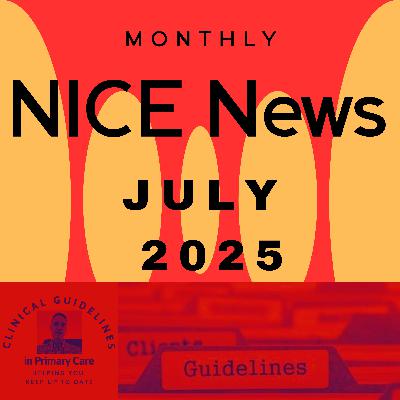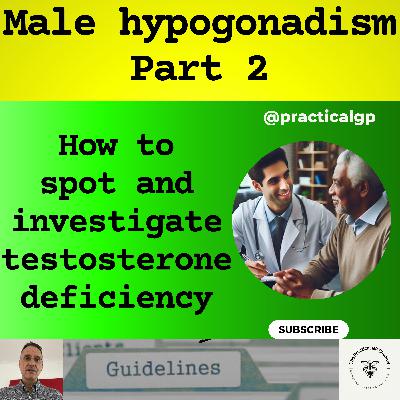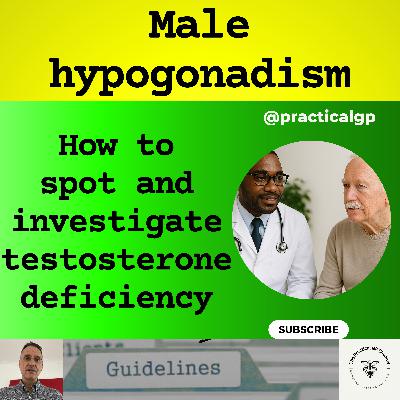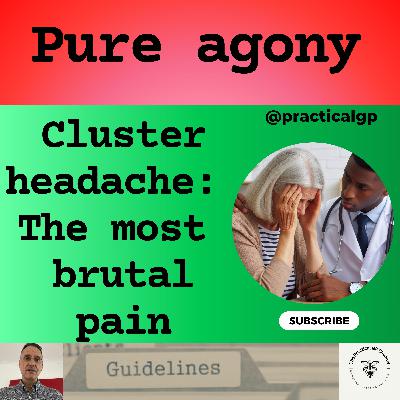Podcast - Sugar, Spice & NICE Advice: The Draft NICE Guideline on Type 2 Diabetes- Part 3
Description
The video version of this podcast can be found here:
· https://youtu.be/AC3ncdm77Os
This episode makes reference to guidelines produced by the "National Institute for Health and Care Excellence" in the UK, also referred to as "NICE". The content on this channel reflects my professional interpretation/summary of the guidance and I am in no way affiliated with, employed by or funded/sponsored by NICE.
NICE stands for "National Institute for Health and Care Excellence" and is an independent organization within the UK healthcare system that produces evidence-based guidelines and recommendations to help healthcare professionals deliver the best possible care to patients, particularly within the NHS (National Health Service) by assessing new health technologies and treatments and determining their cost-effectiveness; essentially guiding best practices for patient care across the country.
My name is Fernando Florido and I am a General Practitioner in the United Kingdom. In this episode I go through the draft NICE guideline on type 2 diabetes, which is open for public consultation until October 2025, and the final guidance being due in February 2026. Today’s episode is based on the NICE visual summary and the link to it is below.
The visual summary includes general guidance for all patient, and specific guidance for 7 different group of patients. In today’s episode we will cover 4 clinical groups and the remaining groups were covered in last week’s episode.
I am not giving medical advice; this video is intended for health care professionals, it is only my summary and my interpretation of the guidelines and you must use your clinical judgement.
Disclaimer:
The Video Content on this channel is for educational purposes and not intended to be a substitute for professional medical advice, diagnosis, or treatment. Always seek the advice of your physician or other qualified health provider with any questions you may have regarding a medical condition. Never disregard professional medical advice or delay in seeking it because of something you have read or seen on this YouTube channel. The statements made throughout this video are not to be used or relied on to diagnose, treat, cure or prevent health conditions.
In addition, transmission of this Content is not intended to create, and receipt by you does not constitute, a physician-patient relationship with Dr Fernando Florido, his employees, agents, independent contractors, or anyone acting on behalf of Dr Fernando Florido.
Intro / outro music: Track: Halfway Through — Broke In Summer [Audio Library Release]
- Music provided by Audio Library Plus
- Watch: https://youtu.be/aBGk6aJM3IU
- Free Download / Stream: https://alplus.io/halfway-through
There is a podcast version of this and other videos that you can access here:
Primary Care guidelines podcast:
· Redcircle: https://redcircle.com/shows/primary-care-guidelines
· Spotify: https://open.spotify.com/show/5BmqS0Ol16oQ7Kr1WYzupK
· Apple podcasts: https://podcasts.apple.com/gb/podcast/primary-care-guidelines/id1608821148
There is a YouTube version of this and other videos that you can access here:
- The Practical GP YouTube Channel:
https://youtube.com/@practicalgp?si=ecJGF5QCuMLQ6hrk
The NICE announcement on Type 2 diabetes management can be found here:
· https://www.nice.org.uk/news/articles/biggest-shake-up-in-type-2-diabetes-care-in-a-decade-announced
The NICE draft guideline on Type 2 diabetes can be found here:
· https://www.nice.org.uk/guidance/gid-ng10336/documents/450
The visual summary of the NICE draft guideline on type 2 diabetes can be found here:
· https://www.nice.org.uk/guidance/GID-NG10336/documents/draft-guideline-2
Transcript
If you are listening to this podcast on YouTube, for a better experience, switch to the video version. The link is in the top right corner of the video and in the episode description.
Hello and welcome! I’m Fernando, a GP in the UK. In today’s episode, we are going to review the draft NICE guideline on type 2 diabetes, focusing on the main changes as applied to 7 specific groups of patients. In the previous episode we covered the first 3 groups so today we will cover the rest.
Right, let’s jump into it.
And, as you know, the draft guideline is open for consultation until October, and the final guidance is due in February 2026, so let’s not forget that it is only a draft, and we should not be making clinical decisions based on it yet.
Today’s episode is based on the visual summary created by NICE and the link to it is in the episode description.
The visual summary includes specific guidance for 7 different groups of patients:
1. The group of patients with no relevant comorbidities, then
2. Obesity
3. Frailty
4. CKD
5. Heart failure
6. Atherosclerotic cardiovascular disease and
7. Early onset type 2 diabetes
And today we will look at the last 4 groups that we did not cover last time.
So let’s start with the CKD group.
For people with CKD, like for many of the other groups. the draft guideline recommends starting treatment with metformin plus an SGLT-2 inhibitor. Because of licensing reasons, we are advised to choose either empagliflozin or dapagliflozin in this group. If metformin is contraindicated or not tolerated, the SGLT-2 inhibitor can be offered on its own.
Treatment will also depend on kidney function, measured by eGFR. As we know, metformin in contraindicated if eGFR is less than 30, and, given that SGLT-2 efficacy decreases with advancing renal impairment, NICE recommends not using empagliflozin or dapagliflozin is eGFR is less than 20.
Therefore, the first line treatment on this basis is as follows:
- If eGFR is above 30 mL/min/1.73 m², in principle we will offer metformin plus dapagliflozin or empagliflozin, although, if metformin is not tolerated the SGLT-2 inhibitor can be given by itself.
- If eGFR is between 20 and 30, we will offer either dapagliflozin or empagliflozin alone.
- And, if eGFR is below 20, we will then go for a DPP-4 inhibitor in preference. If that is contraindicated or not tolerated, we will consider pioglitazone or insulin, given that sulfonylureas should not be given if the eGFR is below 30. This is because sulfonylureas accumulate in renal impairment and increase the hypoglycaemia risk.
If further glycaemic lowering is needed after first line treatment, we can use other options including DPP-4 inhibitors (if not already used), sulfonylureas or insulin depending on renal function and safety profile.
How does this differ from the previous guidance?
Like in other groups, the big change here is the earlier, more proactive use of SGLT-2 inhibitors specifically for renal protection, not just glucose lowering. Previously, SGLT-2 inhibitors were used after metformin for people with established albuminuria or heart failure. Now, the draft guidance recognises the trial evidence showing that, apart from the cardiovascular benefits, SGLT2 inhibitors also reduce progression of CKD, and this benefit occurs even in people with moderately reduced eGFR and independently of albuminuria. The slower progression of CKD is because SGLT2 inhibitors reduce albuminuria, intraglomerular pressure and protect against hyperfiltration.
Another nuance is that the draft now pushes dapagliflozin and empagliflozin explicitly into first-line therapy alongside metformin or alone if necessary, with thresholds set according to kidney function. And it also sets out a clear sequence for treatment as eGFR declines, including when to use DPP-4 inhibitors or move to insulin.
What this means in practice is that:
- We will need to check eGFR early and often, as it will determine the choice of treatment.
- Metformin + SGLT-2 inhibitor is the default down to eGFR 30; SGLT-2 inhibitor alone is preferred between 20 and 30, and below 20, we will switch to a DPP-4 inhibitor, and only after that will we consider pioglitazone or insulin if needed.
- And, practically, the bigger focus on protecting kidney function means that more patients will be started on dapagliflozin or empagliflozin earlier, so we will need to familiarise ourselves with renal thresholds and side effect monitoring.
Now, let’s move to the heart failure group.
For adults with type 2 di


